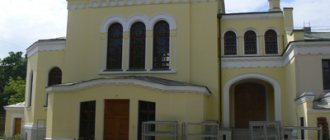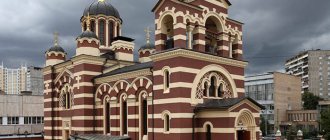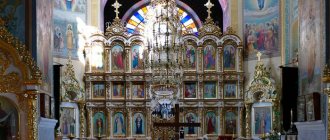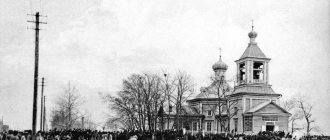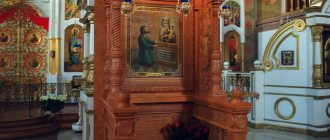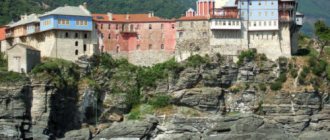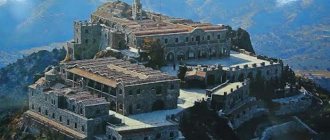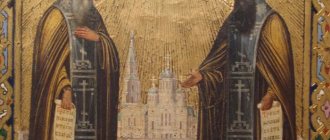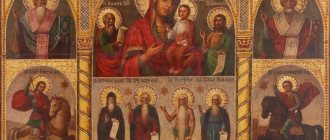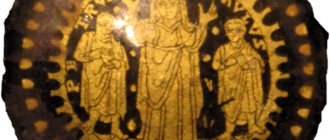Description of the image of the Blessed Virgin Mary
The canvas belongs to the category of not made by hands. This means that the image appeared to people in a miraculous way and began to be revered by Orthodox believers due to its special influence. The icon is classified as a miraculous image due to repeated cases of miraculous healing.
According to historians, the image was found no later than the 15th century on Mount Athos. The original is kept there to this day, having survived numerous restorations.
The history of the image is wonderful. The way the Mother of God is drawn is not the Orthodox canon. This image is unique. According to chroniclers, the figures, which were arranged in a traditional manner, suddenly changed position, creating a new image and forcing us to look at the canvas in a new way.
“Consolation and Consolation” of the canonical type is an image of the Virgin Mary with a baby in her arms. The mother is dressed in a red traditional chiton, her head is covered with a hood. The son she holds in her arms extends his right hand upward. The mother lovingly supports the baby's hand, tilting her head to the right. The look expresses humility, love and submission.
The son holds a scroll with his other hand, which speaks of his unusual origin, his desire to compile lists on which the Word of God is imprinted. Warmth emanates from the canvas. This is emphasized by the selected shades: all colors belong to a warm color palette, do not irritate the eyes, and evoke a feeling of calm.
A detail that indicates severity and humility is the image of a lamp. Images of a mother and baby are traditional, but not canonical in the literal sense. Official paintings are characterized by the image of the Mother of God as the people's intercessor. Most often she holds the baby in her arms, but expresses nothing but respect. On this canvas, the image clearly shows the all-consuming love for his son, the desire to preserve his infancy. Therefore, the image is revered and also loved by mothers of all ages.
Athos Icon of the Mother of God
The image of the Mother of God “Consolation and Consolation” is among the most revered.
Today, there are several options for the names of the miraculous image. Tradition allows at least three: not only “Consolation”, but also “Consolation”, “Consolation”. In Greece the name "Paramithia" is accepted.
Image of the Mother of God “Consolation and Consolation” from the Vatopedi Monastery on Mount Athos
History of the icon
Sources tell different stories about the discovery of the icon. According to one version, the image was never written on the board, as is usually the case. A small fragment of wall painting was placed in the icon case.
Useful materials
An icon painter of the 16th century painted an image of the Mother of God on the wall of the temple of the Vatopedi monastery on Athos. According to custom, after Matins the monks approached the image of the Mother of God and kissed Her hand. It was at such a moment that the Ever-Deva turned to the abbot and warned him about the impending attack of enemies. The monastery was saved, and in gratitude for the help, the monks cut out the fresco and enclosed it in an icon case.
The title “Consolation and Consolation” goes back to another story about the discovery of the icon.
At the very beginning of the 9th century, the Vatopedi Monastery was attacked by robbers. During morning prayer, the abbot of the monastery heard a voice, the source of which was the icon. The Mother of God warned him about the upcoming trials and ordered him not to open the doors of the monastery, but to climb the fortress walls and repel the enemy's attack.
The Divine Son objected to His Mother. His words were harsh:
"Let them be punished."
The monks understood that for their sins they deserved punishment and were ready to accept it with humility. But the Ever-Virgin held the Baby’s hand and turned her head towards Him, interceding for the people.
The shocked inhabitants of the monastery saw how the figures on the icon changed their position. Since then, the icon “Consolation and Consolation” has been revered as evidence of the mercy of the Mother of God, Her intercession and help to people. Through Her prayers, the Lord forgives people’s sins and cancels just punishment.
The akathist to Our Lady of Vatopedi contains the following words:
“Rejoice, you who by your intercession quench the righteous wrath of God; Rejoice, you who incline us to His mercy.”
Meaning
Icon of the Mother of God “Consolation and Consolation”
“Hodegetria” (from the Greek word “Guide”) is one of the most ancient and widespread types of Mother of God icons. The Mother of God holds the Baby Jesus in her arms and shows Him to the viewer. Her gesture is a call to salvation, a proposal for the Path that a person should follow after Christ. According to legend, the author of this type of icon was the Evangelist Luke.
This type spread in the east, in particular, the “Hodegetria” are the “Smolensk”, “Iverskaya” and “Kazan” icons of the Mother of God.
On the icon “Consolation and Consolation” the Ever-Virgin is depicted from the waist up. Her left hand, as it were, serves as a throne for the Divine Child. The icon painter depicted Jesus as a Bishop. He has a scroll in one hand, He raised the other, and the Mother of God tenderly bowed to it.
Tradition tells that the icon acquired its current form miraculously when the Mother of God turned to Her Son with intercession on behalf of the monks. The memory of this is the gesture of the Ever-Virgin Mary, who stops the punishing hand of the Lord. The face of the Mother of God “Consolation and Consolation” is distinguished by a special compassionate expression, mercy and desire to calm and console those praying.
Celebration day
The celebration of the icon takes place on February 3.
How does prayer to the Most Holy Theotokos help in front of this image?
Before this icon, believers pray to the Mother of God;
- about forgiveness of sins and pardon;
- about turning away the righteous wrath of God;
- about consolation in sorrows and sorrows.
Interesting fact
Tradition tells that through the intercession of the Mother of God the son of Emperor Theodosius the Great was saved from death. During a sea voyage, Arkady fell overboard due to a strong storm. The young man’s salvation was miraculous - through the prayer of the Ever-Virgin, he found himself on the shore alive and well. In this place, his father, grateful to the Mother of God for her help, ordered the construction of the Vatopedi Monastery, in the main temple of which an icon was installed, called “Consolation and Consolation” or “Our Lady of Vatopedi”.
Where is
The icon is located on Mount Athos, in the Church of the Annunciation of the Vatopedi Monastery.
Every day the monks serve a prayer service before the miraculous image, and every week they serve the Divine Liturgy.
Lists are especially revered in Russia
St. Demetrius of Rostov in prayer before the Vatopedi icon. Second half of the 18th century. School or art. center of Rostov.
In Rostov, in the Spaso-Yakovlevsky Monastery, a list is kept, revered by pilgrims. Pilgrims often travel to St. Petersburg, where there is an icon of “Consolation and Consolation” in the Kazan Church of the Novodevichy Convent.
A copy of the miraculous icon of the Mother of God “Consolation and Consolation” was painted in the Vatopedi Monastery in 2015 for the Khanty-Mansi Metropolis.
Temples in honor of the icon “Consolation and Consolation”
Temples consecrated in honor of the Mother of God icons have always been built in Russia. There are churches that believers simply call “Consolation and Consolation” in everyday life in Moscow - this is the Cossack Church on Khodynskoye Field, st. Polikarpova, 16. The church was built in memory of Grand Duke Sergei Alexandrovich Romanov 1907 - 1909. During Soviet times, the temple was closed and partially destroyed.
5
January
2019
The church was returned to the believers, in the same year the temple was consecrated and its revival began.
Author: Maria Noskova
Film: "Consolation and Consolation"
Icon of the Mother of God “Consolation and Consolation”
Meaning in Orthodoxy
The veneration of the Mother of God by Christians is easily explained. This is one of my favorite images. Intercessor, patroness, mentor, mother of everything and everyone, who comprehended the depth of great grief and knew the price of sacrifice. This is exactly how the Mother of God appears.
Vatopedi belongs to the group of places that are most visited by pilgrims from all over the world. Christians strive to express their respect and see “Consolation and Consolation” with their own eyes.
History of appearance and acquisition
The discovery of the Vatopedi icon is associated with the events of 807. According to the chronicles, the abbot of the Athos monastery traditionally performed prayers in front of the iconostasis, among which there was a canonical image of the Mother of God with Jesus.
Suddenly the image began to move, the mother turned her head to the right and warned the abbot about the attack of the robber detachment on the monastery. After the attack was repelled, the abbot of the monastery returned to the iconostasis. He saw that the figures on the canvas had completely changed their position. This was an unprecedented miracle, about which rumors immediately spread.
The monks of the monastery considered the baby’s gesture to be a desire to prevent the mother from uttering a warning. They began to pray more earnestly, hoping to earn God's blessing. Because of this, the painting received another interpretation. According to many chroniclers, the Mother of God, frozen on the canvas, acts as an intercessor of people who convinces her strict son to be more lenient.
What do they ask for in front of the icon?
The celebration takes place on February 3. Before the face they ask for the following:
- that sins or mistakes may be forgiven;
- about receiving consolation after the death of relatives and friends;
- to avoid God's wrath after doing wrong.
The Mother of God traditionally helps mothers when they pray for protection, help for children, and guidance for the lost.
Prayers
The day of veneration of the image is February 3.
Troparion to the Most Holy Theotokos before the icon of Her Vatopedi, called “Consolation” or “Consolation”, tone 4
As the gracious and saving cover/ of the acquirer of Thy honorable icon, Mother of God,/ looking at this with tenderness, we cry out to Thee:/ Lady, grant us joy and consolation,/ for I trust in Thee We place our trust in sin and humility./ We hope in Your intercession, unworthiness./ Hasten to deliver us from troubles and sorrows/ and beg Thy Son, Christ our God,// to have mercy and save our souls.
Troparion to the Most Holy Theotokos before the icon of Her of Vatopedi, called “Consolation” or “Consolation”
We are now diligent to the Mother of God, / sinners and humility, and let us fall, / calling in repentance from the depths of our souls: / Lady, help, who have had mercy on us, / struggling, we are perishing from many sins ./ Do not turn away your vain slaves, // You and the one hope of the imams.
Kontakion to the Most Holy Theotokos before the icon of Her Vatopedi, called “Consolation” or “Consolation”, tone 8
To the chosen Voivode, victorious,/ as having got rid of the evil ones,/ let us write thanksgiving to Thee, Thy servants, to the Mother of God,/ but, as having an invincible power,/ free us from all troubles, let us call Thee: // Rejoice , Bride Non-bride.
Prayer to the Most Holy Theotokos before the icon of Her Vatopedi, called “Consolation” or “Consolation”
Hope to all the ends of the earth, the Most Pure Virgin Mary, our Consolation and Joy! Do not disdain us sinners, for we trust in Your mercy. Quench the flame of sin and water our withered hearts with repentance. Cleanse our mind from sinful thoughts. Accept prayers offered to You from the soul and heart with sighing. Be an intercessor for us to Your Son and God and turn His anger away from us with Mother’s prayers. Strengthen the Orthodox faith in us, put in us the spirit of the fear of God, the spirit of humility, patience and love. Heal mental and physical ulcers, calm the storm of evil enemy attacks. Take away the burden of our sins and do not leave us to perish until the end. Give us Your mercy and Your holy blessing to all those present and praying here, and always remain with us, giving those who come to You consolation and consolation, help and intercession, may we glorify and magnify You until after The day of our sighing. Amen.
( 7 ratings, average: 5.00 out of 5)
